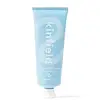What's inside
What's inside
 Key Ingredients
Key Ingredients

 Benefits
Benefits

 Concerns
Concerns

No concerns
 Ingredients Side-by-side
Ingredients Side-by-side

Water
Skin ConditioningAloe Barbadensis Leaf Juice
Skin ConditioningCaprylic/Capric Triglyceride
MaskingPropanediol
SolventGlyceryl Stearate
EmollientGlycerin
HumectantGlyceryl Stearate Citrate
EmollientCetearyl Alcohol
EmollientTocopheryl Acetate
AntioxidantBenzyl Alcohol
PerfumingDehydroacetic Acid
PreservativePotassium Sorbate
PreservativeParfum
MaskingXanthan Gum
EmulsifyingVeronica Officinalis Extract
Skin ConditioningWater
Skin ConditioningTocopheryl Acetate
AntioxidantGlycerin
HumectantLimnanthes Alba Seed Oil
Skin ConditioningCetyl Alcohol
EmollientGlyceryl Stearate Citrate
EmollientChamomilla Recutita Flower Extract
MaskingStearyl Alcohol
EmollientCaprylic/Capric Triglyceride
MaskingCoco-Caprylate
EmollientDiheptyl Succinate
EmollientCapryloyl Glycerin/Sebacic Acid Copolymer
Skin ConditioningGlyceryl Stearate
EmollientAvena Sativa Kernel Extract
AbrasiveAllantoin
Skin ConditioningPanthenol
Skin ConditioningAloe Barbadensis Leaf Extract
EmollientPersea Gratissima Oil
Skin ConditioningGinkgo Biloba Leaf Extract
Skin ConditioningGlyceryl Caprylate
EmollientCaprylhydroxamic Acid
Water, Tocopheryl Acetate, Glycerin, Limnanthes Alba Seed Oil, Cetyl Alcohol, Glyceryl Stearate Citrate, Chamomilla Recutita Flower Extract, Stearyl Alcohol, Caprylic/Capric Triglyceride, Coco-Caprylate, Diheptyl Succinate, Capryloyl Glycerin/Sebacic Acid Copolymer, Glyceryl Stearate, Avena Sativa Kernel Extract, Allantoin, Panthenol, Aloe Barbadensis Leaf Extract, Persea Gratissima Oil, Ginkgo Biloba Leaf Extract, Glyceryl Caprylate, Caprylhydroxamic Acid
Ingredients Explained
These ingredients are found in both products.
Ingredients higher up in an ingredient list are typically present in a larger amount.
This ingredient is an emollient, solvent, and texture enhancer. It is considered a skin-softener by helping the skin prevent moisture loss.
It helps thicken a product's formula and makes it easier to spread by dissolving clumping compounds.
Caprylic Triglyceride is made by combining glycerin with coconut oil, forming a clear liquid.
While there is an assumption Caprylic Triglyceride can clog pores due to it being derived from coconut oil, there is no research supporting this.
Learn more about Caprylic/Capric TriglycerideGlycerin is already naturally found in your skin. It helps moisturize and protect your skin.
A study from 2016 found glycerin to be more effective as a humectant than AHAs and hyaluronic acid.
As a humectant, it helps the skin stay hydrated by pulling moisture to your skin. The low molecular weight of glycerin allows it to pull moisture into the deeper layers of your skin.
Hydrated skin improves your skin barrier; Your skin barrier helps protect against irritants and bacteria.
Glycerin has also been found to have antimicrobial and antiviral properties. Due to these properties, glycerin is often used in wound and burn treatments.
In cosmetics, glycerin is usually derived from plants such as soybean or palm. However, it can also be sourced from animals, such as tallow or animal fat.
This ingredient is organic, colorless, odorless, and non-toxic.
Glycerin is the name for this ingredient in American English. British English uses Glycerol/Glycerine.
Learn more about GlycerinGlyceryl Stearate is a mix of glycerin and stearic acid.
It is used to stabilize the mixing of water and oil ingredients. By preventing these ingredients from separating, it can help elongate shelf life. It can also help thicken the product's texture.
As an emollient, it helps soften skin and supports barrier-replenishing ingredients.
In cosmetics, Glyceryl Stearate is often made from vegetable oils or synthetically produced.
This ingredient may not be fungal-acne safe
Fun fact: The human body also creates Glyceryl Stearate naturally.
Learn more about Glyceryl StearateGlyceryl Stearate Citrate is a citric acid ester of glyceryl stearate.
It is an emulsifier, emollient, and a surfactant.
Emulsifiers help stabilize a product. It does this by preventing certain ingredients from separating. Common ingredients include oils and water, which do not mix naturally. Emulsifiers have properties that help keep ingredients such as these together.
Emollients help soothe and soften the skin. They do this by creating a protective film on your skin. This barrier helps trap moisture and keeps your skin hydrated. Emollients may be effective at treating dry or itchy skin.
Surfactants help gather oils, dirt, and other pollutants from the skin. This helps them to be easily rinsed away.
Learn more about Glyceryl Stearate CitrateTocopheryl Acetate is AKA Vitamin E. It is an antioxidant and protects your skin from free radicals. Free radicals damage the skin by breaking down collagen.
One study found using Tocopheryl Acetate with Vitamin C decreased the number of sunburned cells.
Tocopheryl Acetate is commonly found in both skincare and dietary supplements.
Learn more about Tocopheryl AcetateWater. It's the most common cosmetic ingredient of all. You'll usually see it at the top of ingredient lists, meaning that it makes up the largest part of the product.
So why is it so popular? Water most often acts as a solvent - this means that it helps dissolve other ingredients into the formulation.
You'll also recognize water as that liquid we all need to stay alive. If you see this, drink a glass of water. Stay hydrated!
Learn more about Water